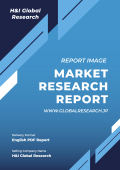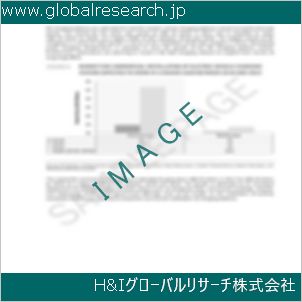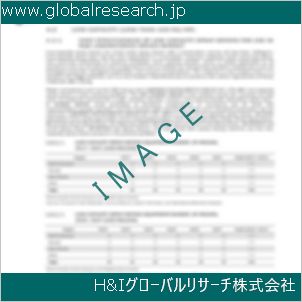| ◆英語タイトル:DNA Methylation Market by Product (Consumables, Kits and Reagents, Enzymes, Instrument and Software), Technology (Polymerase Chain Reaction (PCR), Microarray, Sequencing, and Others), Application (Gene Therapy, Clinical Research, Diagnostics, and Others), End User (Hospital and Diagnostic Laboratories, Pharmaceutical and Biotechnology Companies, Research and Academia), and Region 2023-2028
|
 | ◆商品コード:IMARC23AP149
◆発行会社(リサーチ会社):IMARC
◆発行日:2023年3月2日
◆ページ数:145
◆レポート形式:英語 / PDF
◆納品方法:Eメール
◆調査対象地域:グローバル
◆産業分野:バイオ
|
◆販売価格オプション
(消費税別)
※
販売価格オプションの説明はこちらで、
ご利用ガイドはこちらでご確認いただけます。
※お支払金額は「換算金額(日本円)+消費税+配送料(Eメール納品は無料)」です。
※Eメールによる納品の場合、通常ご注文当日~2日以内に納品致します。
※レポート納品後、納品日+5日以内に請求書を発行・送付致します。(請求書発行日より2ヶ月以内の銀行振込条件、カード払いに変更可)
※上記の日本語題名はH&Iグローバルリサーチが翻訳したものです。英語版原本には日本語表記はありません。
※為替レートは適宜修正・更新しております。リアルタイム更新ではありません。
アイマーク社の本調査資料によると、2022年に13億ドルであった世界のDNAメチル化市場規模が、2028年までに29.3億ドルとなり、予測期間中にCAGR14.60%で拡大すると見込まれています。本書は、DNAメチル化の世界市場を徹底的に分析し、市場の現状や今後の動向をまとめた資料です。序論、範囲・調査手法、エグゼクティブサマリー、イントロダクション、製品別(消耗品、キット・試薬、酵素、機器・ソフトウェア)分析、技術別(ポリメラーゼ連鎖反応(PCR)、マイクロアレイ、シーケンシング、その他)分析、用途別(遺伝子治療、臨床研究、診断、その他)分析、 エンドユーザー別(病院・診断研究所、製薬・バイオテクノロジー企業、研究・学術機関)分析、地域別(北米、アジア太平洋、ヨーロッパ、中南米、中東・アフリカ)分析、要因・制約・機会、バリューチェーン分析、ポーターズファイブフォース分析、価格分析、競争状況など、以下の構成で掲載しています。また、本書内には、Abcam plc.、Active Motif Inc.、Diagenode S.A. (Hologic Inc.)、EpiGentek Group Inc.、Illumina Inc.、Merck KGaA、New England Biolabs Inc.、PerkinElmer Inc.、Qiagen N.V.、Thermo-Fisher Scientific Inc.、Zymo Research Corporationなど、参入企業情報が含まれています。
・序論
・範囲・調査手法
・エグゼクティブサマリー
・イントロダクション
・世界のDNAメチル化市場規模:製品別
- 消耗品の市場規模
- キット・試薬の市場規模
- 酵素の市場規模
- 機器・ソフトウェアの市場規模
・世界のDNAメチル化市場規模:技術別
- ポリメラーゼ連鎖反応(PCR)における市場規模
- マイクロアレイにおける市場規模
- シーケンシングにおける市場規模
- その他における市場規模
・世界のDNAメチル化市場規模:用途別
- 遺伝子治療における市場規模
- 臨床研究における市場規模
- 診断における市場規模
- その他における市場規模
・世界のDNAメチル化市場規模:エンドユーザー別
- 病院・診断研究所における市場規模
- 製薬・バイオテクノロジー企業における市場規模
- 研究・学術機関における市場規模
・世界のDNAメチル化市場規模:地域別
- 北米のDNAメチル化市場規模
- アジア太平洋のDNAメチル化市場規模
- ヨーロッパのDNAメチル化市場規模
- 中南米のDNAメチル化市場規模
- 中東・アフリカのDNAメチル化市場規模
・要因・制約・機会
・バリューチェーン分析
・ポーターズファイブフォース分析
・価格分析
・競争状況 |
Market Overview:
The global DNA methylation market size reached US$ 1.30 Billion in 2022. Looking forward, IMARC Group expects the market to reach US$ 2.93 Billion by 2028, exhibiting a growth rate (CAGR) of 14.60% during 2023-2028. The increasing prevalence of chronic diseases, rising number of clinical trials, and the growing adoption of organic farming practices represent some of the key factors driving the market.
Deoxyribonucleic acid (DNA) methylation is an epigenetic mechanism used by cells to control gene expression. It occurs when a methyl group (CH3) is added to the 5 position of the cytosine, followed by a guanine in the DNA sequence. It is used as a biomarker to identify specific genetic markers that are associated with certain diseases or conditions. It is also utilized to manipulate gene expression in plants for allowing the development of new plant varieties with desirable traits, such as improved yield, disease resistance, and tolerance to environmental stresses. It can also be used as a tool for forensic identification and determination of familial relationships and help in the investigation of crimes. As a result, it is widely utilized across the globe to perform various laboratory applications and study biological systems and the evolution of different species.
DNA Methylation Market Trends:
The surging prevalence of severe chronic diseases, such as cancer, diabetes, lupus, rheumatoid arthritis, hypertension, Alzheimers, and Parkinsons, represents one of the major factors driving the demand for DNA methylation around the world. Moreover, the increasing aging population, which is more prone to these disorders, and increasing improvement in medical infrastructure and diagnostic technologies are bolstering the growth of the market. In addition, the rising preference for personalized medicines and new generation drugs and formulations is favoring the market growth. Apart from this, increasing cases of genetic disorders, including muscular dystrophy and cystic fibrosis, are contributing to the market growth. Furthermore, the expanding number of clinical trials by pharmaceutical companies is propelling the growth of the market. Besides this, changing climatic conditions, declining arable land, rising food security concerns, and the growing awareness about the harmful effects of chemical-based fertilizers are catalyzing the need for eco-friendly solutions to improve crop yield. This, coupled with the increasing adoption of organic farming practices that involve the chemical-free production of crops and seeds and the shifting consumer preferences for organic food products, is strengthening the growth of the market. Additionally, measures undertaken by governments and non-governmental organizations (NGOs) of several countries to make quality healthcare facilities accessible are anticipated to create a positive outlook for the market.
Key Market Segmentation:
IMARC Group provides an analysis of the key trends in each segment of the global DNA methylation market, along with forecasts at the global, regional, and country level from 2023-2028. Our report has categorized the market based on product, technology, application, and end user.
Product Insights:
Consumables
Kits and Reagents
Enzymes
Instrument and Software
The report has provided a detailed breakup and analysis of the DNA methylation market based on the product. This includes consumables, kits and reagents, enzymes, and instrument and software. According to the report, consumables represented the largest segment.
Technology Insights:
Polymerase Chain Reaction (PCR)
Microarray
Sequencing
Others
A detailed breakup and analysis of the DNA methylation market based on the application has also been provided in the report. This includes polymerase chain reaction (PCR), microarray, sequencing, and others. According to the report, sequencing accounted for the largest market share.
Application Insights:
Gene Therapy
Clinical Research
Diagnostics
Others
The report has provided a detailed breakup and analysis of the DNA methylation market based on the application. This includes gene therapy, clinical research, diagnostics, and others. According to the report, clinical research represented the largest segment.
End User Insights:
Hospital and Diagnostic Laboratories
Pharmaceutical and Biotechnology Companies
Research and Academia
A detailed breakup and analysis of the DNA methylation market based on the end user has also been provided in the report. This includes hospital and diagnostic laboratories, pharmaceutical and biotechnology companies, and research and academia. According to the report, pharmaceutical and biotechnology companies accounted for the largest market share.
Regional Insights:
North America
United States
Canada
Asia-Pacific
China
Japan
India
South Korea
Australia
Indonesia
Others
Europe
Germany
France
United Kingdom
Italy
Spain
Russia
Others
Latin America
Brazil
Mexico
Others
Middle East and Africa
The report has also provided a comprehensive analysis of all the major regional markets, which include North America (the United States and Canada); Asia Pacific (China, Japan, India, South Korea, Australia, Indonesia, and others); Europe (Germany, France, the United Kingdom, Italy, Spain, Russia, and others); Latin America (Brazil, Mexico, and others); and the Middle East and Africa. According to the report, North America was the largest market for DNA methylation. Some of the factors driving the North America DNA methylation market included the increasing awareness about early diagnosis, rising product launches, easy availability of adequate treatment, etc.
Competitive Landscape:
The report has also provided a comprehensive analysis of the competitive landscape in the global tea market. Competitive analysis such as market structure, market share by key players, player positioning, top winning strategies, competitive dashboard, and company evaluation quadrant has been covered in the report. Also, detailed profiles of all major companies have been provided. Some of the companies covered Abcam plc., Active Motif Inc., Diagenode S.A. (Hologic Inc.), EpiGentek Group Inc., Illumina Inc., Merck KGaA, New England Biolabs Inc., PerkinElmer Inc., Qiagen N.V., Thermo-Fisher Scientific Inc., Zymo Research Corporation, etc. Kindly note that this only represents a partial list of companies, and the complete list has been provided in the report.
Key Questions Answered in This Report:
How has the global DNA methylation market performed so far, and how will it perform in the coming years?
What are the drivers, restraints, and opportunities in the global DNA methylation market?
What is the impact of each driver, restraint, and opportunity on the global DNA methylation market?
What are the key regional markets?
Which countries represent the most attractive DNA methylation markets?
What is the breakup of the market based on the product?
Which is the most attractive product in the DNA methylation market?
What is the breakup of the market based on the technology?
Which is the most attractive technology in the DNA methylation market?
What is the breakup of the market based on the application?
Which is the most attractive application in the DNA methylation market?
What is the breakup of the market based on the end user?
Which is the most attractive end user in the DNA methylation market?
What is the competitive structure of the global DNA methylation market?
Who are the key players/companies in the global DNA methylation market?
1 Preface
2 Scope and Methodology
2.1 Objectives of the Study
2.2 Stakeholders
2.3 Data Sources
2.3.1 Primary Sources
2.3.2 Secondary Sources
2.4 Market Estimation
2.4.1 Bottom-Up Approach
2.4.2 Top-Down Approach
2.5 Forecasting Methodology
3 Executive Summary
4 Introduction
4.1 Overview
4.2 Key Industry Trends
5 Global DNA Methylation Market
5.1 Market Overview
5.2 Market Performance
5.3 Impact of COVID-19
5.4 Market Forecast
6 Market Breakup by Product
6.1 Consumables
6.1.1 Market Trends
6.1.2 Market Forecast
6.2 Kits and Reagents
6.2.1 Market Trends
6.2.2 Market Forecast
6.3 Enzymes
6.3.1 Market Trends
6.3.2 Market Forecast
6.4 Instrument and Software
6.4.1 Market Trends
6.4.2 Market Forecast
7 Market Breakup by Technology
7.1 Polymerase Chain Reaction (PCR)
7.1.1 Market Trends
7.1.2 Market Forecast
7.2 Microarray
7.2.1 Market Trends
7.2.2 Market Forecast
7.3 Sequencing
7.3.1 Market Trends
7.3.2 Market Forecast
7.4 Others
7.4.1 Market Trends
7.4.2 Market Forecast
8 Market Breakup by Application
8.1 Gene Therapy
8.1.1 Market Trends
8.1.2 Market Forecast
8.2 Clinical Research
8.2.1 Market Trends
8.2.2 Market Forecast
8.3 Diagnostics
8.3.1 Market Trends
8.3.2 Market Forecast
8.4 Others
8.4.1 Market Trends
8.4.2 Market Forecast
9 Market Breakup by End User
9.1 Hospital and Diagnostic Laboratories
9.1.1 Market Trends
9.1.2 Market Forecast
9.2 Pharmaceutical and Biotechnology Companies
9.2.1 Market Trends
9.2.2 Market Forecast
9.3 Research and Academia
9.3.1 Market Trends
9.3.2 Market Forecast
10 Market Breakup by Region
10.1 North America
10.1.1 United States
10.1.1.1 Market Trends
10.1.1.2 Market Forecast
10.1.2 Canada
10.1.2.1 Market Trends
10.1.2.2 Market Forecast
10.2 Asia-Pacific
10.2.1 China
10.2.1.1 Market Trends
10.2.1.2 Market Forecast
10.2.2 Japan
10.2.2.1 Market Trends
10.2.2.2 Market Forecast
10.2.3 India
10.2.3.1 Market Trends
10.2.3.2 Market Forecast
10.2.4 South Korea
10.2.4.1 Market Trends
10.2.4.2 Market Forecast
10.2.5 Australia
10.2.5.1 Market Trends
10.2.5.2 Market Forecast
10.2.6 Indonesia
10.2.6.1 Market Trends
10.2.6.2 Market Forecast
10.2.7 Others
10.2.7.1 Market Trends
10.2.7.2 Market Forecast
10.3 Europe
10.3.1 Germany
10.3.1.1 Market Trends
10.3.1.2 Market Forecast
10.3.2 France
10.3.2.1 Market Trends
10.3.2.2 Market Forecast
10.3.3 United Kingdom
10.3.3.1 Market Trends
10.3.3.2 Market Forecast
10.3.4 Italy
10.3.4.1 Market Trends
10.3.4.2 Market Forecast
10.3.5 Spain
10.3.5.1 Market Trends
10.3.5.2 Market Forecast
10.3.6 Russia
10.3.6.1 Market Trends
10.3.6.2 Market Forecast
10.3.7 Others
10.3.7.1 Market Trends
10.3.7.2 Market Forecast
10.4 Latin America
10.4.1 Brazil
10.4.1.1 Market Trends
10.4.1.2 Market Forecast
10.4.2 Mexico
10.4.2.1 Market Trends
10.4.2.2 Market Forecast
10.4.3 Others
10.4.3.1 Market Trends
10.4.3.2 Market Forecast
10.5 Middle East and Africa
10.5.1 Market Trends
10.5.2 Market Breakup by Country
10.5.3 Market Forecast
11 Drivers, Restraints, and Opportunities
11.1 Overview
11.2 Drivers
11.3 Restraints
11.4 Opportunities
12 Value Chain Analysis
13 Porters Five Forces Analysis
13.1 Overview
13.2 Bargaining Power of Buyers
13.3 Bargaining Power of Suppliers
13.4 Degree of Competition
13.5 Threat of New Entrants
13.6 Threat of Substitutes
14 Price Analysis
15 Competitive Landscape
15.1 Market Structure
15.2 Key Players
15.3 Profiles of Key Players
15.3.1 Abcam plc.
15.3.1.1 Company Overview
15.3.1.2 Product Portfolio
15.3.1.3 Financials
15.3.1.4 SWOT Analysis
15.3.2 Active Motif Inc.
15.3.2.1 Company Overview
15.3.2.2 Product Portfolio
15.3.3 Diagenode S.A. (Hologic Inc.)
15.3.3.1 Company Overview
15.3.3.2 Product Portfolio
15.3.4 EpiGentek Group Inc.
15.3.4.1 Company Overview
15.3.4.2 Product Portfolio
15.3.5 Illumina Inc.
15.3.5.1 Company Overview
15.3.5.2 Product Portfolio
15.3.5.3 Financials
15.3.5.4 SWOT Analysis
15.3.6 Merck KGaA
15.3.6.1 Company Overview
15.3.6.2 Product Portfolio
15.3.6.3 Financials
15.3.6.4 SWOT Analysis
15.3.7 New England Biolabs Inc.
15.3.7.1 Company Overview
15.3.7.2 Product Portfolio
15.3.8 PerkinElmer Inc.
15.3.8.1 Company Overview
15.3.8.2 Product Portfolio
15.3.8.3 Financials
15.3.8.4 SWOT Analysis
15.3.9 Qiagen N.V.
15.3.9.1 Company Overview
15.3.9.2 Product Portfolio
15.3.9.3 Financials
15.3.9.4 SWOT Analysis
15.3.10 Thermo-Fisher Scientific Inc.
15.3.10.1 Company Overview
15.3.10.2 Product Portfolio
15.3.10.3 Financials
15.3.10.4 SWOT Analysis
15.3.11 Zymo Research Corporation
15.3.11.1 Company Overview
15.3.11.2 Product Portfolio
Kindly note that this only represents a partial list of companies, and the complete list has been provided in the report.
❖ 免責事項 ❖http://www.globalresearch.jp/disclaimer












